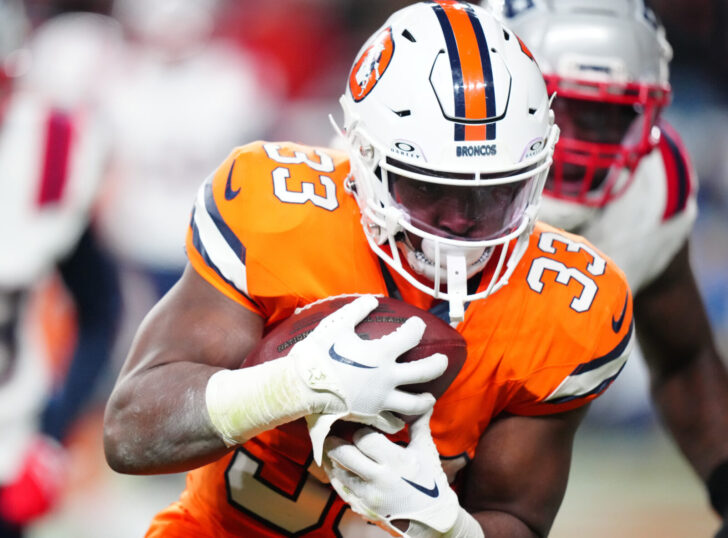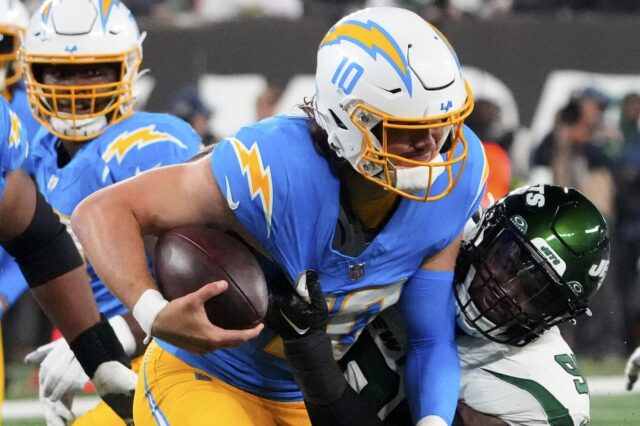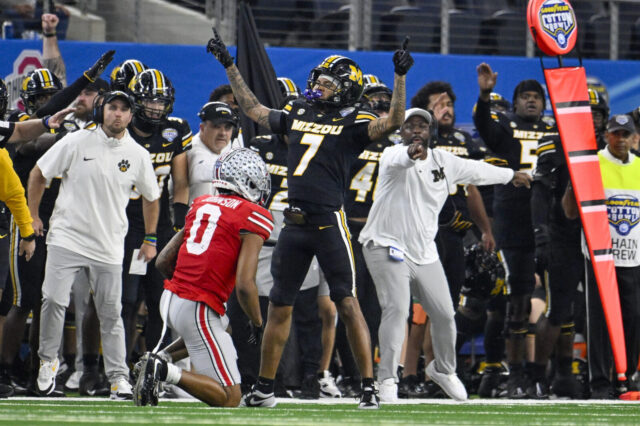There were high expectations for the Denver Broncos’ offense in 2023 in Sean Payton’s first year as the team’s head coach, especially with the team’s rushing attack. Unfortunately, those expectations weren’t met, and now the running back position has several questions heading into the offseason.
Denver Broncos rushing attack not good enough for sustained success last season
‘Inconsistent’ may be the best word to describe the Broncos’ offense last season. While so many eyes are rightly focused on the team’s quarterback position, that really isn’t the reason Denver’s offense wasn’t good enough last year – but imbalance was.
To build a productive offense that remains sustainable week in and week out, there has to be a balance between the run and passing game. There were times this season, especially early on, when the team had to abandon the run game because they trailed by two or more scores at crucial junctures of a game.
In totality, the Broncos finished the year with 1,810 combined rushing yards and only eight rushing touchdowns. Javonte Williams led the way with 774 yards on 217 attempts (3.6 yards per carry) and three rushing touchdowns. Quarterback Russell Wilson was the team’s second-leading rusher, with 341 yards on the ground on 80 attempts (4.3 yards per carry) and three rushing touchdowns.
While rookie Jaleel McLaughlin ran one into the end zone against the Washington Commanders in Week 2, it wasn’t until Week 12 of the NFL season that Denver scored their second rushing touchdown of the year, when Samaje Perine punched it in against the Cleveland Browns.
That was a huge problem throughout the year, as teams sold out against the run, forcing Denver to rely heavily on their passing game. Despite the criticism he’s received, that’s where Wilson came up big for the team, accounting for 26 passing touchdowns compared to just eight interceptions. Wilson also tied for the team lead in rushing touchdowns with three of his own.
While everybody wants to point fingers at Wilson or head coach Sean Payton, there were a lot of dirty hands involved in Denver’s inconsistent offensive production, and the lack of an overall running game was a major culprit.
That will need to be addressed this offseason if Denver hopes to be better on offense in 2024.
Will Javonte Williams bounce back in 2024?
Football is such a gladiator sport that everybody forgets the human side of a player’s performance or production. Javonte Williams made a almost-miraculous recovery after a major knee surgery, and still found a way to be ready for the start of training camp.
Oftentimes, after a player suffers an ACL injury, it can take significant time for them to return to form and get back to being the player they were pre-injury – Adrian Peterson famously excluded.
Williams experienced a career-low 3.6 yards per carry in 2023 and often faced a stacked box. There were times it appeared as if his vision hitting the hole was inconsistent, but for as often as Denver’s offense struggled, any positive yards were a good thing for them.
Despite the struggles in the rushing game, Williams still led the team in broken tackles with 11, according to Pro Football Reference. Even though Williams didn’t have the strongest season in his return from a major injury, I’d encourage Broncos Country to show him some grace and give him some room to breathe.
Williams has the entire offseason to get even stronger, and this extra time to get rest should benefit him when the team gears up for 2024. His size and downhill running are important for Payton’s offense, and I can tell you that Payton hasn’t lost confidence in Williams or what he can bring to the table offensively.
What will Samaje Perine and Jaleel McLaughlin’s roles be in 2024?
The Broncos RB2 position last year changed at the beginning, middle, and end parts of the season, which contributed to more inconsistency. At the beginning of the year, undrafted rookie free agent Jaleel McLaughlin emerged as the guy behind Javonte with his electrifying speed and ball-carrier vision.
His size became an issue for Denver from a tendency standpoint, because opposing defenses picked up on him being the main target as a rusher or in the passing game when he was on the field for them. He struggled from a pass protection standpoint due to his size, but his effort, attitude, and willingness to block are things that the team can continue to build on.
McLaughlin was the team’s third-leading rusher, running the ball 76 times for 410 yards and one rushing touchdown. As a receiver, he hauled in 31 catches for 160 yards and two receiving touchdowns.
“It’s a great question,” Payton said, regarding the team’s expectations for McLaughlin at the end of the season. “Our vision continues to grow a little bit, because he continues to earn additional touches… Periodically, he’ll come up and he wants to expand his role as a receiver in that, if you will, ‘Joker’ category. He’s certainly eager. There’s a unique –- not physicality – but I would say physicality, and a unique, hard-to-hit trait he has. You don’t see him take hard hits. He’s very sudden, and he’s earned those touches.”
I’d guess that McLaughlin might put on five to seven pounds this offseason if he hopes to have an expanded role this upcoming season. For the middle part of the season, Samaje Perine emerged as the team’s RB2, especially in passing situations.
He quickly became one of Russell Wilson’s favorite targets, especially on third down. He hauled in 50 receptions on 56 targets for 455 yards through the air.
Of his 50 catches, 23 of them moved the chains for a first down. Perine saw 53 carries for 238 yards and one rushing touchdown.
Right now, it’s unclear what Payton or the team’s plans are for 2024, whether they’ll run it back with all three backs or add to the position room.
One thing is very clear, and that’s the fact that Denver’s offense has to be better at running the football, and they’ll need more than just eight rushing touchdowns throughout 17 games to be competitive.



